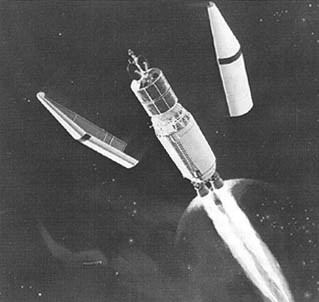 | ||
A payload fairing is a nose cone used to protect a spacecraft (launch vehicle payload) against the impact of dynamic pressure and aerodynamic heating during launch through an atmosphere. More recently, an additional function is to maintain the cleanroom environment for precision instruments.
Contents
Outside the atmosphere the fairing is jettisoned, exposing the payload. At this moment mechanical shocks and a spike in acceleration might be observed.
The standard payload fairing is typically a cone-cylinder combination, due to aerodynamic considerations; however specialized fairings are in use as well. The type of fairing which separates into two halves upon jettisoning is called a clamshell fairing by way of analogy to the bifurcating shell of a clam.
In some cases the fairing may enclose both the payload and the upper stage of the rocket, such as on Atlas V and Proton M.
If the payload is attached both to the booster's core structures and to the fairing, the payload may still be affected by the fairing's bending loads, as well as inertia loads due to vibrations caused by gusts and buffeting.
Mission failures caused by payload fairings
In some cases the fairing is planned to separate after cutoff of the upper stage, and in others the separation is to occur before cutoff, but after the vehicle has transcended the densest part of the atmosphere. Failure of the fairing to separate in these cases may cause the craft to fail to reach orbit, due to the extra mass.
The Augmented Target Docking Adapter, to be used for the Gemini 9A manned mission, was successfully placed into orbit by an Atlas SLV-3 in June 1966. But when the Gemini crew rendezvoused with it, they discovered the fairing had failed to open and separate, making docking impossible. Two lanyards, which should have been removed before flight, were still in place. The cause was determined to be a launch crew error.
In 1999, the launch of the IKONOS-1 Earth observation satellite failed after the payload fairing of the Athena II rocket did not open properly, preventing the satellite from reaching orbit.
On February 24, 2009, NASA's Orbiting Carbon Observatory satellite failed to reach orbit after liftoff presumably because the fairing on the Taurus XL launch vehicle failed to separate, causing the vehicle to retain too much mass and subsequently fall back to Earth; whatever didn't burn up landed in the Indian Ocean near Antarctica.
The same happened to the Naro-1, South Korea's first carrier rocket, launched on 25 August 2009. During the launch half of the payload's fairing failed to separate, and as a result the rocket was thrown off course. The satellite did not reach a stable orbit.
On March 4, 2011 NASA's Glory satellite launch failed to reach orbit after lift-off due to a fairing separation failure on the Orbital Sciences Taurus XL Launch Vehicle, ending up in the Indian Ocean. This failure represented the second consecutive failure of a fairing on an Orbital Sciences Taurus XL vehicle. NASA subsequently decided to switch the launch vehicle for the Orbiting Carbon Observatory's replacement, OCO-2, from a Taurus to a Delta II rocket.
